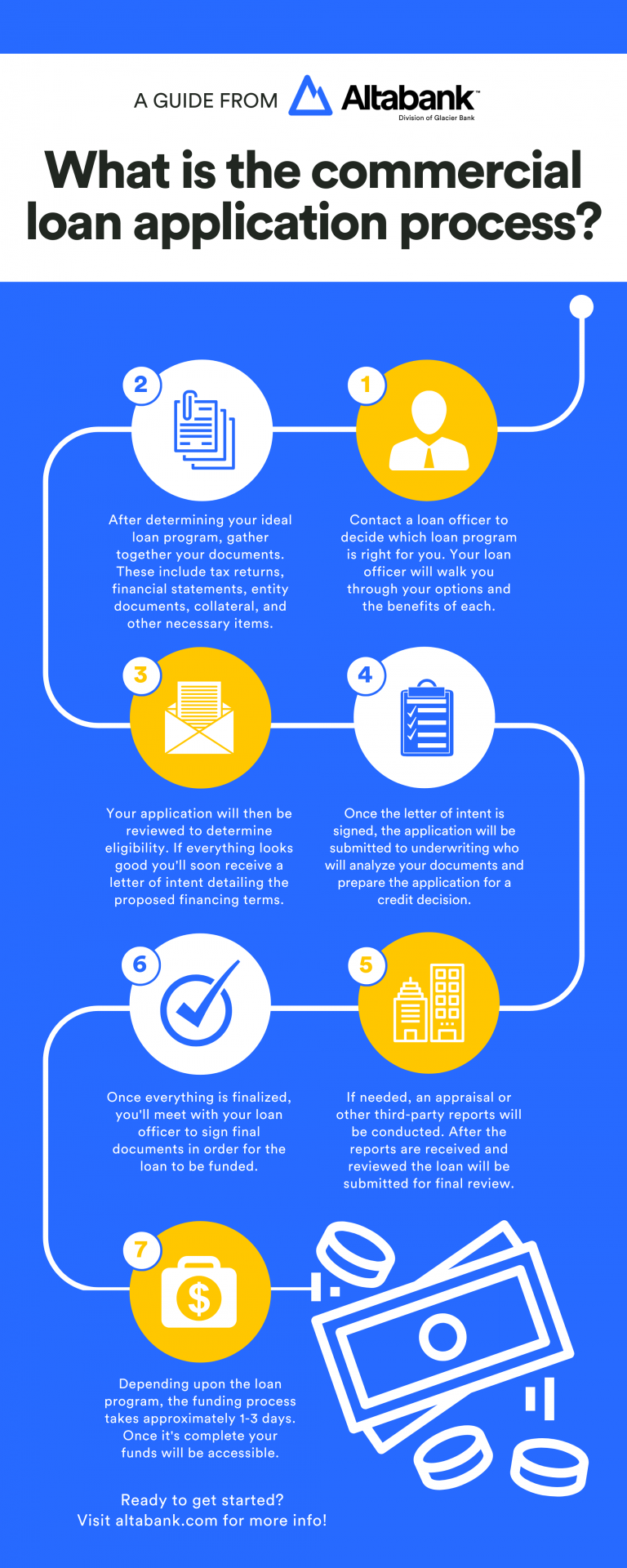What is the Commercial Loan Process
4/8/2020
Interested in getting a commercial loan, but unsure where to start? Our commercial loan process flow chart will help you understand the basics.
Commercial real estate loans, capital lines of credit, equipment loans, construction loans…with so many different loan types available, it’s hard to know where to begin. Should you talk to a loan officer or gather your financial documents first? Do you need to start the process months in advance or could you receive funding within a matter of days? Can you complete an application online or does it have to be in person? Some — or even all — of these questions might run through your mind as you get ready to start the loan application process.
Where should you start?
Step #1: Contact a Loan Officer
Even though most commercial loan applications follow a similar process, it’s important to work with someone familiar with the different requirements and guidelines. When choosing a bank choose a reputable institution that believes in and understands your business and its goals. A bank that understands your business will have extensive experience with lending in your industry and be familiar with the laws and regulations you’ll need to follow.
Usually, the lending institution assigns a loan officer to you based upon your business type and geographic location. Make sure this person is someone who will be a resource and advocate for you. Your loan officer will walk you through the different types of loans and together you will decide which loan program is best for you and your business. You’ll work closely with your loan officer and the bank throughout the application process so it’s important to choose wisely.
Step #2: Complete Your Commercial Loan Application Checklist
Many different documents are required to process a commercial loan. It’s best to follow the commercial loan application checklist your loan officer provides. Usually, this includes at least two to three years of financial records along with your tax returns, entity documents, and collateral information.
Depending on the loan program, you may need to provide further documentation such as a business plan or financial projections. Your loan officer will let you know of any other documentation needed to continue the approval process.
Step #3: Letter of Intent
A letter of intent is a preliminary, non-binding proposal between two parties. In a commercial loan, you and the bank would be the two parties represented. This letter will detail the proposed terms of the loan including the amount of financing and collateral needed as well as the loan’s length and rate.
Letters of intent are not concrete and, in some cases, may be negotiated. Sometimes letters of intent are called loan term letters or loan proposal letters. Once you and your loan officer are satisfied with the offer, your formal application will be submitted to underwriting.
Step #4: Application Submitted to Underwriting
Underwriting is a process in which the lending institution assesses the risks of the loan. It helps reduce the risk of potential liability to you and the bank in the future. During underwriting, trained specialists go through your application to see if you meet the bank’s minimum requirements for a loan. The main factors assessed during underwriting are repayment ability, credit history, financial strength, collateral information, and borrowing structure.
Underwriting ultimately determines whether or not your loan will be approved. Often underwriters will require further information or documentation to finish processing the application.
Step #5: Appraisal and Other Third-Party Reports
Many commercial loans, including those for commercial property, require an appraisal or other valuation as well as third-party reports. Appraisals usually take approximately 3-4 weeks to obtain; however, different factors can affect this timeline positively or negatively. Third-party reports can include title commitments, engineering reports, environmental reports, surveys, and more. Each report has a different timeline.
The appraisal and all other third-party reports need to be returned and approved before underwriting can be completed. As the borrower, it is your responsibility to pay for the third-party reports.
Step #6: Sign Final Documents
If your loan is approved you and your loan officer will arrange a time to discuss and sign the final documents. The signing process usually takes an hour or less to complete. It’s important to be thorough when reviewing these documents.
Step #7: Funding
It’s a common misconception that funds are received the moment final documents are signed. It usually takes 1-3 days for the signed final documents to be processed and the loan to be funded. You will be notified when the funds are available.
In the meantime, take a deep breath and relax. You’ve officially completed the loan application process and received financing. The best part is that you’re not alone. A good lending institution will always be there to support you and answer any questions that might arise in the future.

